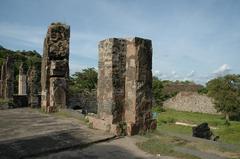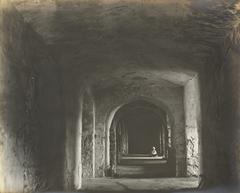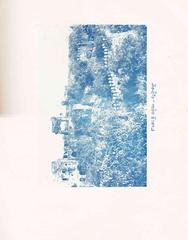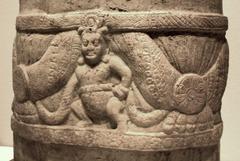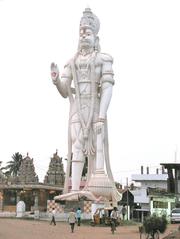
Kondapalli Fort Visitor Guide
Date: 18/07/2024
Introduction
Table of Contents
- Introduction
- Early History and Origins
- Architectural Significance - A Blend of Styles
- Visitor Information - Plan Your Visit
- Legends and Folklore - Tales of Valor and Romance
- Kondapalli Fort Today - A Heritage Site and Tourist Destination
- Special Events, Guided Tours, and Photographic Spots
- Conclusion
- FAQ
- References
Early History and Origins
The fort’s origins can be traced back to the 11th century, during the reign of the Eastern Chalukyas of Vengi. Believed to have been built by Prolaya Vema Reddi, the founder of the Reddi dynasty, the fort initially served as a military stronghold due to its advantageous position on a granite hill.
The Reddi Dynasty and Kondapalli’s Golden Age
The fort reached its zenith under the rule of the Reddi dynasty (1325-1424 AD). Kondapalli flourished as their capital, witnessing significant architectural additions and cultural advancements. The Reddis, known for their patronage of art and literature, transformed the fort into a center of learning and creativity.
The Vijayanagara Empire and a Shift in Power
The 14th century saw the rise of the powerful Vijayanagara Empire. In 1364 AD, Kondapalli Fort fell to the Vijayanagara forces under the command of Kumara Kampana. This marked a significant shift in power dynamics in the region. The Vijayanagara rulers further fortified the fort, adding to its defensive capabilities.
The Qutb Shahi Dynasty and a Flourishing Trade Hub
Following the decline of the Vijayanagara Empire, Kondapalli Fort came under the control of the Qutb Shahi dynasty of Golconda in the 16th century. Under their rule, the fort experienced a period of economic prosperity, becoming a vital center for trade and commerce. The Qutb Shahis, known for their administrative acumen, implemented efficient systems that fostered economic growth in the region.
Mughal Rule and a New Chapter
The Mughal emperor Aurangzeb’s conquest of the Deccan plateau in the late 17th century brought Kondapalli Fort under Mughal control in 1687 AD. The Mughals, recognizing the fort’s strategic importance, maintained it as a military outpost. This era witnessed the integration of Mughal architectural elements into the fort’s structure, further enriching its architectural tapestry.
The French and the British - Colonial Influence and Legacy
The 18th century marked the arrival of European powers in India. Kondapalli Fort, with its strategic value, became a point of contention. In 1759, the fort was captured by the French under the command of Marquis de Conflans. However, their control was short-lived, as the fort was ceded to the British East India Company in 1766. The British, recognizing the fort’s historical and cultural significance, took steps to preserve it.
Architectural Significance - A Blend of Styles
Kondapalli Fort stands as an architectural marvel, showcasing a unique blend of styles reflecting the influences of various dynasties that ruled over it. The fort’s construction, primarily using locally sourced granite, highlights the architectural ingenuity of the builders.
Fortifications and Gateways
The fort’s imposing walls, punctuated by massive gateways, speak volumes about its defensive capabilities. The main entrance, known as the Dargah Darwaza, is an impressive structure adorned with intricate carvings.
Granaries and Tanks
The fort housed massive granaries, a testament to its role as a strategic reserve for food supplies during times of war. Numerous tanks and wells within the fort complex ensured a continuous water supply.
Temples and Palaces
Kondapalli Fort was not just a military stronghold but also a place of worship and royal residence. The ruins of temples dedicated to various deities, including a prominent Hanuman temple, reflect the religious harmony that existed within the fort walls. The remnants of palaces and audience halls provide glimpses into the grandeur of the bygone era.
Visitor Information - Plan Your Visit
To make the most of your visit to Kondapalli Fort, here are some essential details:
- Visiting Hours: The fort is open to visitors from 9:00 AM to 5:00 PM daily.
- Tickets: Entry tickets are priced at INR 20 for Indian citizens and INR 100 for foreign tourists.
- Best Times to Visit: The ideal time to visit is during the cooler months from October to March when the weather is pleasant for exploring.
- Travel Tips: Wear comfortable shoes, carry water, and be prepared for a moderate hike up the hill to reach the fort.
- Nearby Attractions: Don’t miss the nearby Kondapalli village, famous for its traditional wooden toys, and the Kondapalli Reserve Forest, a haven for nature lovers.
- Accessibility: The fort is accessible by road, with regular buses and private taxis available from Vijayawada, located approximately 25 km away.
Legends and Folklore - Tales of Valor and Romance
Kondapalli Fort is steeped in legends and folklore, passed down through generations. These tales, often a blend of history and myth, add a layer of intrigue to the fort’s allure.
The Legend of Prolaya Vema Reddi
Local folklore attributes the fort’s construction to Prolaya Vema Reddi, who is said to have been inspired by a dream to build a fort on the hill.
The Tale of Rani Rudrama Devi
The fort is associated with Rani Rudrama Devi, the valiant queen of the Kakatiya dynasty, known for her courage and administrative skills. Legend has it that she used the fort as a strategic outpost during her reign.
The Story of the Hidden Treasure
Like many ancient forts, Kondapalli Fort has its share of tales of hidden treasures. Local lore speaks of a secret chamber within the fort complex, said to be filled with gold and jewels.
Kondapalli Fort Today - A Heritage Site and Tourist Destination
Today, Kondapalli Fort stands as a protected heritage site, attracting visitors from far and wide. The Archaeological Survey of India (ASI) oversees the fort’s preservation and maintenance. The fort offers a glimpse into the region’s glorious past, captivating visitors with its architectural grandeur, historical significance, and captivating legends.
Special Events, Guided Tours, and Photographic Spots
Kondapalli Fort hosts special events during major Indian festivals, providing visitors with a unique cultural experience. Guided tours are available, offering in-depth insights into the fort’s history and architecture. The fort’s scenic vistas and architectural marvels make it a paradise for photographers, with numerous spots perfect for capturing stunning images.
Conclusion
FAQ
Q: What are the Kondapalli Fort visiting hours?
A: The fort is open to visitors from 9:00 AM to 5:00 PM daily.
Q: How much are the Kondapalli Fort tickets?
A: Entry tickets are priced at INR 20 for Indian citizens and INR 100 for foreign tourists.
Q: What are the best times to visit Kondapalli Fort?
A: The ideal time to visit is during the cooler months from October to March.
Q: Are there guided tours available at Kondapalli Fort?
A: Yes, guided tours are available, providing detailed insights into the fort’s history and architecture.
Q: What other attractions are near Kondapalli Fort?
A: Nearby attractions include the Kondapalli village, known for its traditional wooden toys, and the Kondapalli Reserve Forest.
